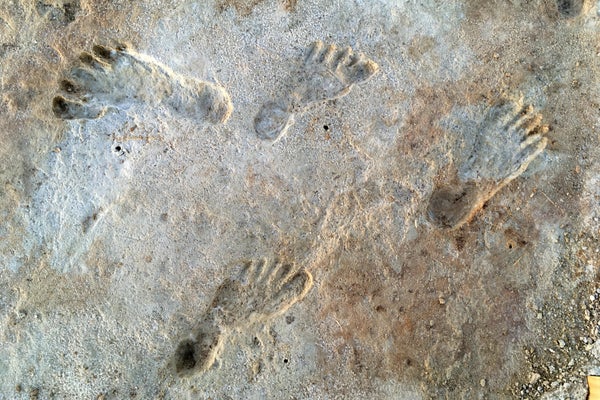Fossilized human footprints found in New Mexico’s White Sands National Park were almost certainly made more than 20,000 years ago, during the height of the last ice age, according to new research. The study, published on Thursday in Science, overthrows decades of thinking about when humans arrived in North America.
The researchers determined the ages of pollen grains and tiny quartz crystals in sediments beside the footprints, which are buried a few feet below the surface. The work confirms a 2021 study’s findings, which were based on radiocarbon dates from aquatic plant seeds in the sediments. The new results “are statistically indistinguishable from the seed ages,” says Jeff Pigati, a geologist at the U.S. Geological Survey and co-lead author of the new study. “We’ve now got three different dating techniques—radiocarbon dating of the seeds, radiocarbon dating of the pollens and luminescence dating of the quartz—that all show people were there.”
The 2021 announcement of the astonishingly ancient age of the footprints, which were found alongside a dried-up lake in the park, created controversy among archaeologists. Until then, many scientists had thought that the Clovis people became the first known Americans when they arrived from the north about 13,000 years ago, as the ice sheets across North America were retreating. (The Clovis are named after a town in New Mexico where their stone spear points were unearthed in the 1930s, but their artifacts have since been found throughout Central and North America.)
On supporting science journalism
If you're enjoying this article, consider supporting our award-winning journalism by subscribing. By purchasing a subscription you are helping to ensure the future of impactful stories about the discoveries and ideas shaping our world today.
The White Sands footprints, however, suggest humans had already lived in New Mexico for thousands of years by the time the Clovis culture began.
Skeptics questioned the dating method used in the 2021 study, which measured the levels of radioactive carbon 14 in seeds of the freshwater plant Ruppia cirrhosa—also known as spiral ditchgrass—in layers of sediment above and below the footprints. The critics argued water might have flowed through ancient rocks before it was absorbed by the seeds and thereby transmitted carbon that could make them seem older than they really were.
But the alternative dating methods refute that idea, says co-lead study author Kathleen Springer, a USGS geologist. “It’s a paradigm-shattering result,” she says. “People were in New Mexico during the Last Glacial Maximum, when the massive ice sheets farther north were [impassable]—that just flies in the face of all ideas about migrations and migratory routes,” she adds, referring to the last ice age’s peak, which occurred between 26,000 and 20,000 years ago.
In the new study, the researchers determined the radiocarbon age of microscopic pollen grains in the sediment layers, which hadn’t grown in the lake water. They also found the pollen came from plants that no longer grow in the area. “There’s pollen from pine and spruce and fir, which grow at much higher elevations today,” Springer says. “So the flora indicates that ecosystem extended down to the valley floor 20,000 years ago.”
The researchers also dated the sediments with a technique called optically stimulated luminescence, which can determine when minerals were last exposed to daylight. Samples for the technique must be processed in the dark, which the scientists achieved by hammering tubes into the buried sediments and studying them under red light that wouldn’t affect the dating, Pigati says. They then measured the almost imperceptible glow of quartz grains in the samples under specific frequencies of light, and the resulting dates matched those from the radiocarbon method, he says.
The new dates confirm the picture of a now vanished landscape at White Sands more than 20,000 years ago, when camels, elephants and giant sloths roamed beside a lake and were probably prey for human hunters. And the human footprints suggest people arrived there up to 30,000 years ago, before the ice sheets made migration from the north impossible.
Some of the White Sands footprints appear on the surface as “ghost tracks," which are only visible when the ground is damp. Scientists think they are caused by water evaporating above fossilized footprints that are buried deeper underground. The team dug a trench in the soil to reveal the buried footprints and take samples for testing. “There are thousands of megafaunal and human footprints at White Sands,” Springer explains. “On some days you can’t see anything, but when the moisture content is just right, they fully pop to your eye.”
Geologist Cynthia Liutkus-Pierce of Appalachian State University, who has studied ancient human footprints in Tanzania and wasn’t involved in the new White Sands research, says the study further supports the presence of humans in North America during the last ice age. “This is exciting and will certainly have scientists rethinking how humans interacted with the North American environment during the [Last Glacial Maximum],” she says.
Anthropologist Kimberly Foecke of the Smithsonian Institution, who also wasn’t involved in the study, is now “reasonably convinced” of the antiquity of the footprints.* “These results add to the still scant but growing evidence of human presence in the Americas around the time of the Last Glacial Maximum,” she says.
*Editor’s Note (10/5/23): This sentence was edited after posting. It originally stated Kimberly Foecke is at George Washington University.
